The Painter Reader’s Guide
By Peter Heller


1. The Painter opens several years before the rest of the narrative, in the bar where Jim fired the shot that changed the course of his life. Why do you think the author chose to open on this moment? How did it color your reading experience? Your perception of Jim?
2. An Ocean of Women is a painting born out of a comment made by Irmina. What was your interpretation of this painting? How does it relate to Jim’s treatment of women? Discuss Jim’s relationships with the following characters: Irmina, Sofia, Celia, Cristine. What similarities, if any, exist in how he treats each of these women? What does he admire about the women?
3. Discuss Jim’s relationship with Sofia. Why do you think he hesitates before initiating a physical relationship with her? In what ways is she a foil for his character?
4. The first-person narrative of The Painter allows for a slow reveal of information about Jim and his past. How did this piecemeal revelation add tension to the discussion of Alce’s death? How did it help to create a more sympathetic character?
5. Expressionism, as an artistic movement, is characterized by a preference for subjectivity over realism. Why do you think the author chooses to have Jim paint in this style? How do the concepts of realism versus subjectivity factor into the larger narrative concerns of The Painter?
6. In the beginning of the novel, Bob advises Jim to “be good.” These words are echoed throughout the novel, particularly as Jim wrestles with his self-image in the face of his increasingly violent behavior. Discuss the difference between being good and goodness as described by Jim on page 303. Is Jim a “good” person? What characters, if any, are “good” or display innate “goodness”?
7. On page 74, Jim describes how he “disappear[s]” in awe when viewing certain paintings and certain scenes of nature. Discuss the choice of wording. How do both art and nature provide a means of escapism for Jim throughout the novel?
8. Explore Jim’s relationship with Irmina. How does he rely on her for emotional support throughout the novel? How does she provide guidance for him?
9. Jim is a mostly self-taught painter. Discuss the moment when he realized that he wanted to paint. How did his experiences in childhood and adolescence influence his decision?
10. Trace the events that cause Jim’s violent side to emerge throughout the novel. What, if anything, do these events have in common?
11. Discuss the significance of the painting of the horse and crow. Why do you think the painting has “changed” in his absence after he assaults Celia’s ex-boyfriend? (page 216)
12. Jim paints for himself, but also needs to paint as a means of economic stability. By the end of the novel, do you think he is more accepting of the relationship between creator and consumer, or do the events in Santa Fe harden him toward the interaction?
13. Discuss the “flash flood” as described on pages 289 to 292. Explore its symbolism in the narrative and the development of Jim as a character. Why do you think he signaled Jason? Was it an instinctual or merciful act?
14. Jim’s relationship with his art dealer, Steve, is fraught with tension. How did you view their relationship? Is it one of mutual respect? Of economic necessity? Do you think Steve is intimidated by Jim’s violent past?
15. When Jim goes to Santa Fe, he finds himself in the center of a media maelstrom, carefully constructed by Steve. Discuss Jim’s reaction to becoming a public figure. Why do you think he is most chagrined by the “blogger?”(page 320)
16. How does Jim’s guilt over his actions—both over Alce and his violent behavior—manifest throughout the novel? How does he take to the canvas to mitigate his pain?
17. As you were reading, did you think Jason was going to kill Jim in the last scene of the book? Why do you think he spared his life?
18. Jim inhabits many roles throughout the novel: artist, father, spouse, lover, fisherman, criminal, celebrity. Which role makes him happiest? Which brings about the most conflict in his life?
Just for joining you’ll get personalized recommendations on your dashboard daily and features only for members.
Find Out More Join Now Sign In